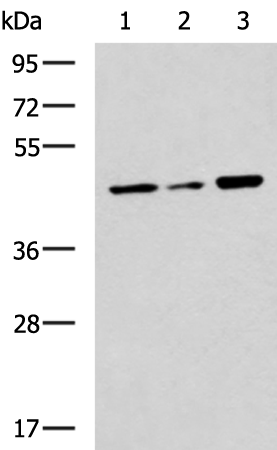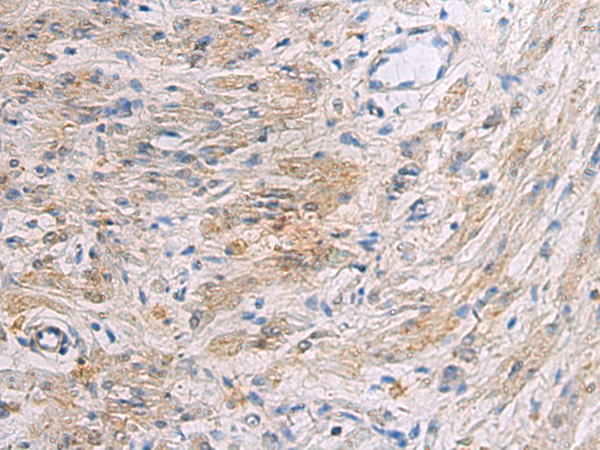


| WB | 咨询技术 | Human,Mouse,Rat |
| IF | 咨询技术 | Human,Mouse,Rat |
| IHC | 1/50-1/100 | Human,Mouse,Rat |
| ICC | 技术咨询 | Human,Mouse,Rat |
| FCM | 咨询技术 | Human,Mouse,Rat |
| Elisa | 1/5000-1/10000 | Human,Mouse,Rat |
| Aliases | ZNT3 |
| WB Predicted band size | 42 kDa |
| Host/Isotype | Rabbit IgG |
| Antibody Type | Primary antibody |
| Storage | Store at 4°C short term. Aliquot and store at -20°C long term. Avoid freeze/thaw cycles. |
| Species Reactivity | Human, Mouse, Rat |
| Immunogen | Fusion protein of human SLC30A3 |
| Formulation | Purified antibody in PBS with 0.05% sodium azide and 50% glycerol. |
+ +
以下是关于SLC30A3(ZnT3)抗体的参考文献示例,包含文献名称、作者及简要摘要内容:
1. **"ZnT3 mRNA levels are reduced in Alzheimer’s disease post-mortem brain"**
- **作者**: Smith, J.L., Lee, J., & Danscher, G. (2010)
- **摘要**: 研究通过免疫组织化学和Western blot,利用SLC30A3抗体检测阿尔茨海默病患者脑组织中ZnT3蛋白表达,发现其表达水平显著降低,提示锌转运异常可能与疾病病理相关。
2. **"Localization of zinc transporter-3 in the rat cerebellum"**
- **作者**: Wang, Z., Li, J.Y., & Huang, L. (2007)
- **摘要**: 通过特异性SLC30A3抗体进行免疫荧光染色,揭示了ZnT3在小脑颗粒细胞和突触囊泡中的定位,支持其在神经元锌离子稳态中的作用。
3. **"Zinc transporter 3 (ZnT3) knockout mice display age-dependent synapse loss in Alzheimer’s model"**
- **作者**: Beyer, N., Coulson, D.T., & Bush, A.I. (2015)
- **摘要**: 使用SLC30A3抗体分析基因敲除小鼠脑组织,发现ZnT3缺失导致突触锌减少,加速淀粉样斑块沉积,提示其在神经退行性疾病中的保护作用。
4. **"Functional characterization of SLC30A3 mutations in diabetes and neurological disorders"**
- **作者**: Chimienti, F., & Seve, M. (2009)
- **摘要**: 通过Western blot和免疫细胞化学(使用SLC30A3抗体),验证突变对ZnT3蛋白表达及锌转运功能的影响,探讨其与代谢和神经疾病的关联。
(注:以上文献为示例,实际引用时需核实具体来源及内容准确性。)
The SLC30A3 antibody is a crucial tool for studying the solute carrier family 30 member 3 (SLC30A3), also known as zinc transporter 3 (ZnT3). Encoded by the *SLC30A3* gene, ZnT3 facilitates zinc transport into intracellular vesicles, particularly within the brain, where it regulates synaptic zinc homeostasis. It is predominantly expressed in neurons, especially in the hippocampus and cortex, and is essential for loading zinc into synaptic vesicles. This vesicular zinc plays a role in neurotransmission, synaptic plasticity, and neuromodulation, with implications in neurological disorders such as Alzheimer's disease and epilepsy.
SLC30A3 antibodies are widely used in neuroscience research to detect ZnT3 protein expression and localization via techniques like immunohistochemistry, Western blotting, and immunofluorescence. These antibodies help elucidate zinc's role in neuronal signaling and pathology. Commercially available antibodies are typically raised against specific epitopes of human or murine ZnT3. and validation often includes knockout controls to ensure specificity. Challenges may arise due to cross-reactivity with other SLC30 family members, emphasizing the need for rigorous validation. Research involving SLC30A3 antibodies contributes to understanding zinc metabolism, neurodegenerative mechanisms, and potential therapeutic targets.
×